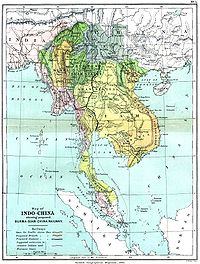French Indochina
French Indochina (French: L'Indochine française, Vietnamese: Đông Dương thuộc Pháp) was the part of the French colonial empire in Indochina in southeast Asia, consisting of a federation of four protectorates (Tonkin, Annam, Cambodia and Laos) and one directly-ruled colony (Cochinchina). The capital of French Indochina was Hanoi. FormationFrench Indochina was formed in October 1887 from Annam, Tonkin, Cochinchina (who together form modern Vietnam) and the Kingdom of Cambodia; Laos was added after the Franco-Siamese War of 1893. The federation lasted until 1954. In the four protectorates, the French formally left the local rulers in power, who were the Emperors of Vietnam, Kings of Cambodia, and Kings of Luang Prabang, but in fact gathered all powers in their hands, the local rulers acting only as figureheads. Antebellum From 1885 to 1895, Phan Đình Phùng led a rebellion against the colonizing power. Nationalist sentiments intensified in Vietnam, especially during and after World War I, but all the uprisings and tentative efforts failed to obtain any concessions from the French overseers. On February 10 1930, there was an uprising by Vietnamese soldiers in the French colonial army's Yen Bai garrison. The "Yên Bái mutiny" was sponsored by the Việt Nam Quốc Dân Đảng (VNQDD). The VNQDD was the Vietnamese Nationalist Party. The attack was the largest disturbance against the colonisation of Vietnam since Phan Dinh Phung and the "Can Vuong monarchist movement" of the late 19th century. The aim of the revolt was to inspire a wider uprising among the general populace in an attempt to overthrow the colonial authority. The VNQDD had previously attempted to engage in clandestine activities to undermine French rule, but increasing French scrutiny on their activities led to their leadership group taking the risk of staging a large scale military attack in the Red River Delta in northern Vietnam. In the 1930s, Siam engaged France in a series of talks concerning the repatriation of Siamese provinces held by the French. By 1938, France had agreed to repatriate Angkor Wat, Angkor Thom, Siam Reap, Siam Pang and the associated provinces (approximately 13) to Siam. Meanwhile, Siam took over control of those areas, in anticipation of the upcoming treaty. Signatories from each country were dispatched to Tokyo to sign the treaty repatriating the lost provinces. World War IIIn September 1940, during World War II, the newly created regime of Vichy France, which was a puppet state of Nazi Germany, granted Japan's demands for military access to Tonkin with the invasion of French Indochina (or Vietnam Expedition). This allowed Japan better access to China in the Second Sino-Japanese War against the forces of Chiang Kai-shek, but it was also part of Japan's strategy for dominion over the Greater East Asia Co-Prosperity Sphere. The Japanese kept the French bureaucracy and leadership in place to run French Indochina. Thailand took this opportunity of weakness to reclaim previously lost territories, resulting in the French-Thai War between October 1940 and 9 May 1941. On 9 March 1945, with France liberated, Germany in retreat, and the United States ascendant in the Pacific, Japan decided to take complete control of Indochina. The Japanese launched the Second French Indochina Campaign. The Japanese kept power in Indochina until the news of their government's surrender came through in August. Vietnamese War of Independence After the war, France had the Franco-Siamese treaty of 1938 nullified and attempted to reassert itself in the region, but came into conflict with the Viet Minh, a coalition of Communist and Vietnamese nationalists under French-educated Ho Chi Minh. During World War II, the United States had supported the Viet Minh in resistance against the Japanese; the group was in control of the country apart from the cities since the French gave way in March 1945. After persuading Emperor Bao Dai to abdicate in his favour, on September 2, 1945 Ho — as president — declared independence for the Democratic Republic of Vietnam. But before the end of September, a force of British, French, and Indian soldiers, along with captured Japanese troops, restored French control. Bitter fighting ensued in the First Indochina War. In 1950 Ho again declared an independent Democratic Republic of Vietnam, which was recognized by the fellow Communist governments of China and the Soviet Union. Fighting lasted until March 1954, when the Viet Minh won the decisive victory against French forces at the gruelling Battle of Dien Bien Phu. This led to the partition of Vietnam into the Democratic Republic of Vietnam in the North, under Viet Minh control, and the State of Vietnam in the South, which had the support of the United States, the United Kingdom, and France. The events of 1954 also marked the end of French involvement in the region, and the beginnings of serious US commitment to South Vietnam which led to the Vietnam War. InsightsThe partition was agreed to at the Geneva Conference, where the United States of America, the Soviet Union, the United Kingdom, France and the People's Republic of China also settled a number of outstanding disputes relating to the Korean War. It was at this conference that France relinquished any claim to territory in the Indochinese peninsula. Laos and Cambodia also became independent in 1954, but were both drawn into the Vietnam War. If Indochina were still a union it would have a population of slightly over 100 million and a GDP of over 280 billion, which would make it the most valuable of the former French colonies, eclipsing the traditionally important colonies of Algeria and French West Africa. See also
External links |
||||||||||||||||||||||||||||||||||||||||||||||||||||||||||||

